Adelaide Nursing School NICS PBL Worksheet: Acute Illness Analysis
VerifiedAdded on 2022/11/16
|5
|1118
|246
Homework Assignment
AI Summary
This assignment presents a student's response to a Problem-Based Learning (PBL) worksheet focused on an acute illness case involving an 11-month-old infant, Chloe, diagnosed with bronchiolitis. The student analyzes the case, identifies key insights, and discusses the impact of these insights on quality patient care. The response covers symptoms, interventions such as oxygen support and fluid therapy, and factors influencing patient outcomes. The student also evaluates the logical clinical sense behind the decisions made, suggests improvements, and explores the role of a multidisciplinary team. Furthermore, the student provides recommendations for enhancing the PBL experience by incorporating different scenarios and focusing on the mother's support and education. References are included to support the analysis. This assignment aims to demonstrate the student's understanding of acute illness management and patient-centered care.
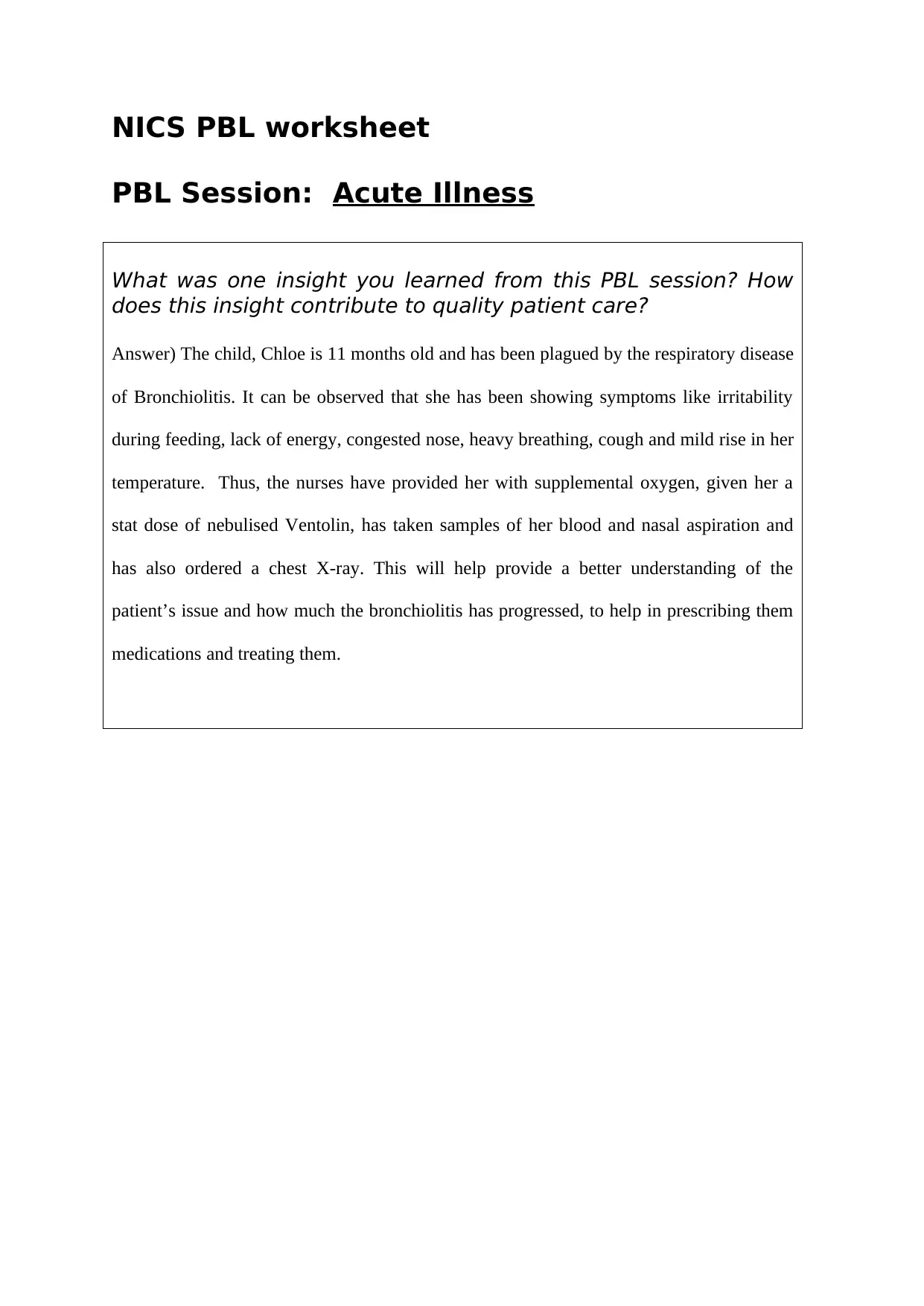
NICS PBL worksheet
PBL Session: Acute Illness
What was one insight you learned from this PBL session? How
does this insight contribute to quality patient care?
Answer) The child, Chloe is 11 months old and has been plagued by the respiratory disease
of Bronchiolitis. It can be observed that she has been showing symptoms like irritability
during feeding, lack of energy, congested nose, heavy breathing, cough and mild rise in her
temperature. Thus, the nurses have provided her with supplemental oxygen, given her a
stat dose of nebulised Ventolin, has taken samples of her blood and nasal aspiration and
has also ordered a chest X-ray. This will help provide a better understanding of the
patient’s issue and how much the bronchiolitis has progressed, to help in prescribing them
medications and treating them.
PBL Session: Acute Illness
What was one insight you learned from this PBL session? How
does this insight contribute to quality patient care?
Answer) The child, Chloe is 11 months old and has been plagued by the respiratory disease
of Bronchiolitis. It can be observed that she has been showing symptoms like irritability
during feeding, lack of energy, congested nose, heavy breathing, cough and mild rise in her
temperature. Thus, the nurses have provided her with supplemental oxygen, given her a
stat dose of nebulised Ventolin, has taken samples of her blood and nasal aspiration and
has also ordered a chest X-ray. This will help provide a better understanding of the
patient’s issue and how much the bronchiolitis has progressed, to help in prescribing them
medications and treating them.
Paraphrase This Document
Need a fresh take? Get an instant paraphrase of this document with our AI Paraphraser
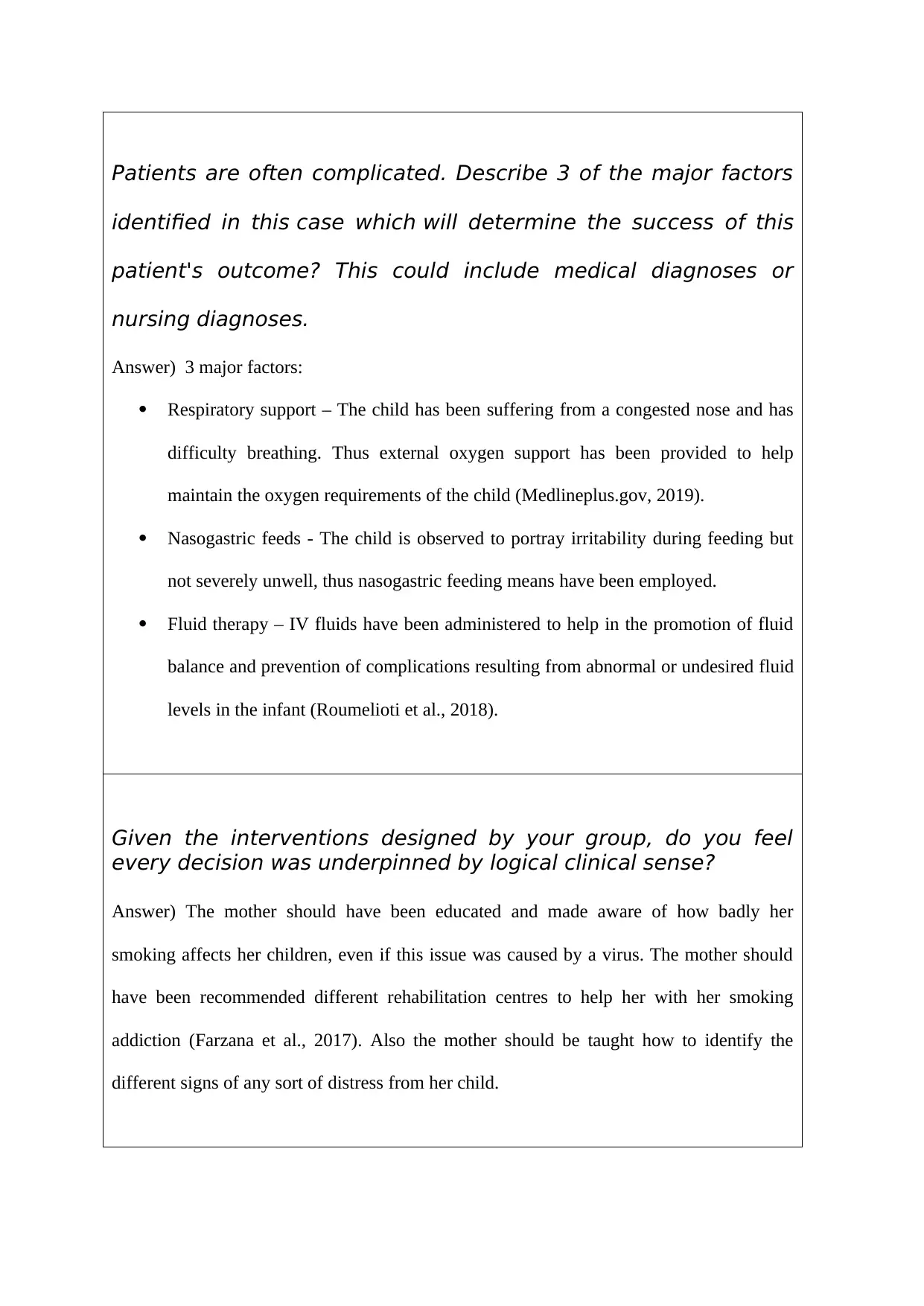
Patients are often complicated. Describe 3 of the major factors
identified in this case which will determine the success of this
patient's outcome? This could include medical diagnoses or
nursing diagnoses.
Answer) 3 major factors:
Respiratory support – The child has been suffering from a congested nose and has
difficulty breathing. Thus external oxygen support has been provided to help
maintain the oxygen requirements of the child (Medlineplus.gov, 2019).
Nasogastric feeds - The child is observed to portray irritability during feeding but
not severely unwell, thus nasogastric feeding means have been employed.
Fluid therapy – IV fluids have been administered to help in the promotion of fluid
balance and prevention of complications resulting from abnormal or undesired fluid
levels in the infant (Roumelioti et al., 2018).
Given the interventions designed by your group, do you feel
every decision was underpinned by logical clinical sense?
Answer) The mother should have been educated and made aware of how badly her
smoking affects her children, even if this issue was caused by a virus. The mother should
have been recommended different rehabilitation centres to help her with her smoking
addiction (Farzana et al., 2017). Also the mother should be taught how to identify the
different signs of any sort of distress from her child.
identified in this case which will determine the success of this
patient's outcome? This could include medical diagnoses or
nursing diagnoses.
Answer) 3 major factors:
Respiratory support – The child has been suffering from a congested nose and has
difficulty breathing. Thus external oxygen support has been provided to help
maintain the oxygen requirements of the child (Medlineplus.gov, 2019).
Nasogastric feeds - The child is observed to portray irritability during feeding but
not severely unwell, thus nasogastric feeding means have been employed.
Fluid therapy – IV fluids have been administered to help in the promotion of fluid
balance and prevention of complications resulting from abnormal or undesired fluid
levels in the infant (Roumelioti et al., 2018).
Given the interventions designed by your group, do you feel
every decision was underpinned by logical clinical sense?
Answer) The mother should have been educated and made aware of how badly her
smoking affects her children, even if this issue was caused by a virus. The mother should
have been recommended different rehabilitation centres to help her with her smoking
addiction (Farzana et al., 2017). Also the mother should be taught how to identify the
different signs of any sort of distress from her child.
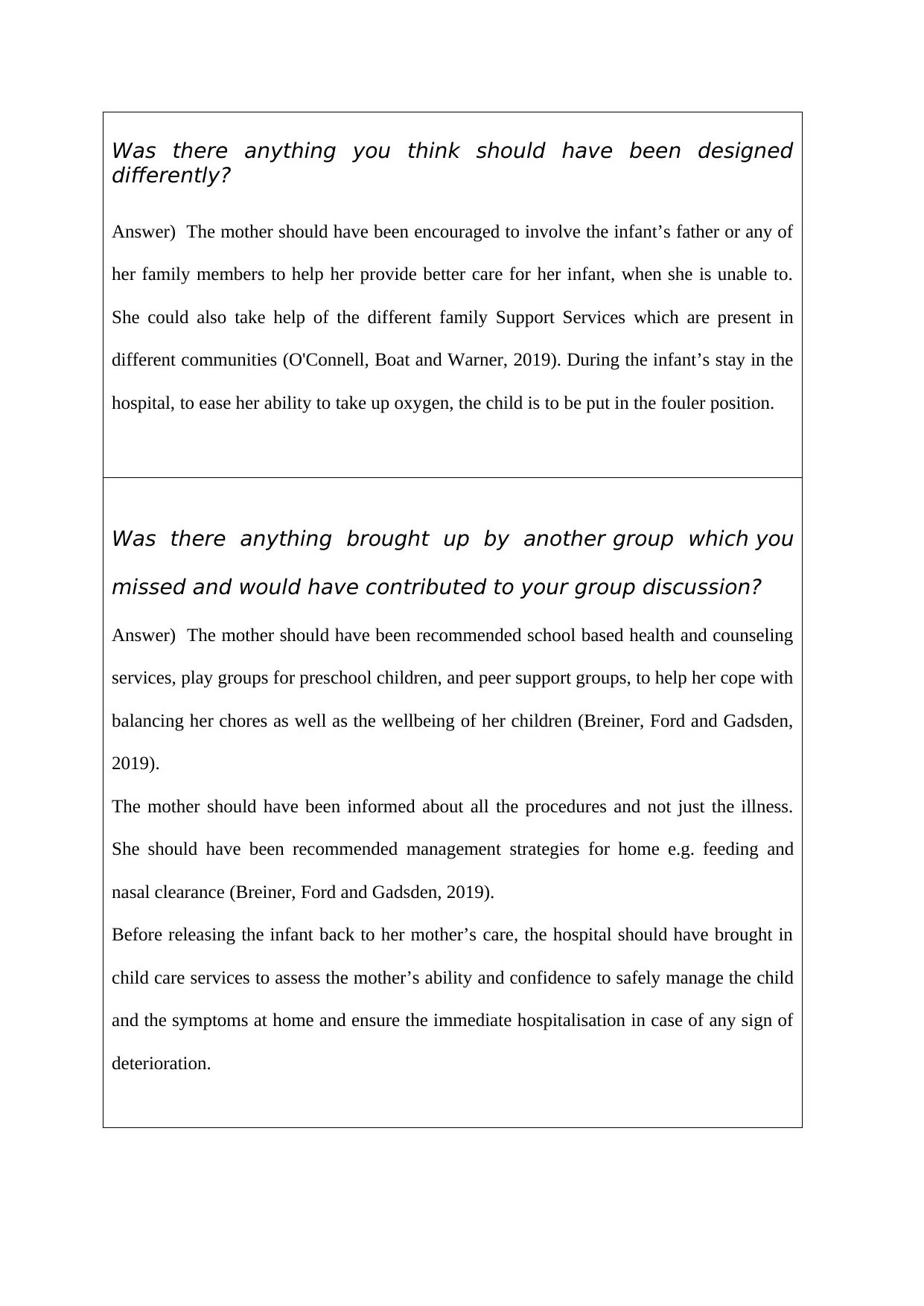
Was there anything you think should have been designed
differently?
Answer) The mother should have been encouraged to involve the infant’s father or any of
her family members to help her provide better care for her infant, when she is unable to.
She could also take help of the different family Support Services which are present in
different communities (O'Connell, Boat and Warner, 2019). During the infant’s stay in the
hospital, to ease her ability to take up oxygen, the child is to be put in the fouler position.
Was there anything brought up by another group which you
missed and would have contributed to your group discussion?
Answer) The mother should have been recommended school based health and counseling
services, play groups for preschool children, and peer support groups, to help her cope with
balancing her chores as well as the wellbeing of her children (Breiner, Ford and Gadsden,
2019).
The mother should have been informed about all the procedures and not just the illness.
She should have been recommended management strategies for home e.g. feeding and
nasal clearance (Breiner, Ford and Gadsden, 2019).
Before releasing the infant back to her mother’s care, the hospital should have brought in
child care services to assess the mother’s ability and confidence to safely manage the child
and the symptoms at home and ensure the immediate hospitalisation in case of any sign of
deterioration.
differently?
Answer) The mother should have been encouraged to involve the infant’s father or any of
her family members to help her provide better care for her infant, when she is unable to.
She could also take help of the different family Support Services which are present in
different communities (O'Connell, Boat and Warner, 2019). During the infant’s stay in the
hospital, to ease her ability to take up oxygen, the child is to be put in the fouler position.
Was there anything brought up by another group which you
missed and would have contributed to your group discussion?
Answer) The mother should have been recommended school based health and counseling
services, play groups for preschool children, and peer support groups, to help her cope with
balancing her chores as well as the wellbeing of her children (Breiner, Ford and Gadsden,
2019).
The mother should have been informed about all the procedures and not just the illness.
She should have been recommended management strategies for home e.g. feeding and
nasal clearance (Breiner, Ford and Gadsden, 2019).
Before releasing the infant back to her mother’s care, the hospital should have brought in
child care services to assess the mother’s ability and confidence to safely manage the child
and the symptoms at home and ensure the immediate hospitalisation in case of any sign of
deterioration.
⊘ This is a preview!⊘
Do you want full access?
Subscribe today to unlock all pages.

Trusted by 1+ million students worldwide
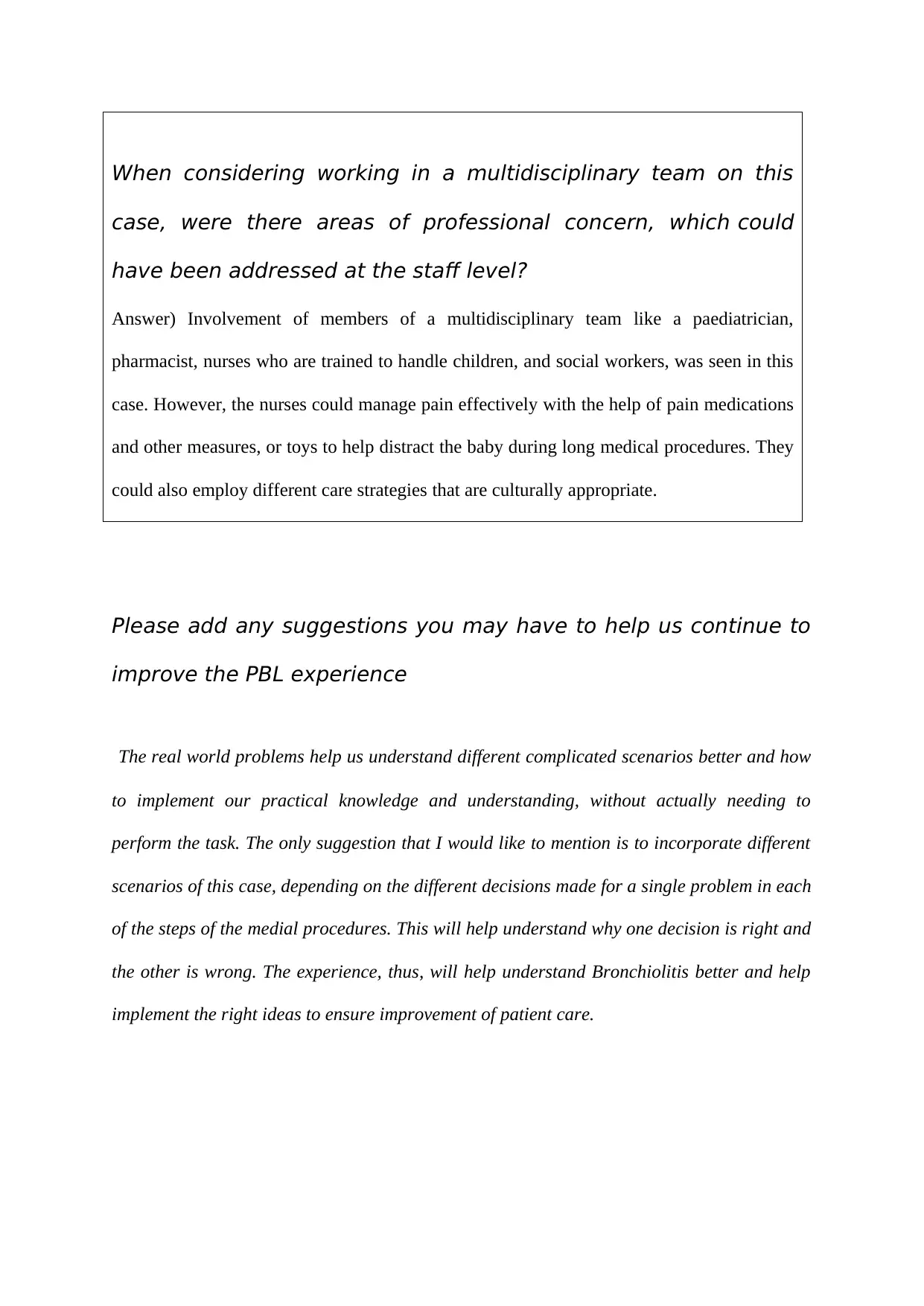
When considering working in a multidisciplinary team on this
case, were there areas of professional concern, which could
have been addressed at the staff level?
Answer) Involvement of members of a multidisciplinary team like a paediatrician,
pharmacist, nurses who are trained to handle children, and social workers, was seen in this
case. However, the nurses could manage pain effectively with the help of pain medications
and other measures, or toys to help distract the baby during long medical procedures. They
could also employ different care strategies that are culturally appropriate.
Please add any suggestions you may have to help us continue to
improve the PBL experience
The real world problems help us understand different complicated scenarios better and how
to implement our practical knowledge and understanding, without actually needing to
perform the task. The only suggestion that I would like to mention is to incorporate different
scenarios of this case, depending on the different decisions made for a single problem in each
of the steps of the medial procedures. This will help understand why one decision is right and
the other is wrong. The experience, thus, will help understand Bronchiolitis better and help
implement the right ideas to ensure improvement of patient care.
case, were there areas of professional concern, which could
have been addressed at the staff level?
Answer) Involvement of members of a multidisciplinary team like a paediatrician,
pharmacist, nurses who are trained to handle children, and social workers, was seen in this
case. However, the nurses could manage pain effectively with the help of pain medications
and other measures, or toys to help distract the baby during long medical procedures. They
could also employ different care strategies that are culturally appropriate.
Please add any suggestions you may have to help us continue to
improve the PBL experience
The real world problems help us understand different complicated scenarios better and how
to implement our practical knowledge and understanding, without actually needing to
perform the task. The only suggestion that I would like to mention is to incorporate different
scenarios of this case, depending on the different decisions made for a single problem in each
of the steps of the medial procedures. This will help understand why one decision is right and
the other is wrong. The experience, thus, will help understand Bronchiolitis better and help
implement the right ideas to ensure improvement of patient care.
Paraphrase This Document
Need a fresh take? Get an instant paraphrase of this document with our AI Paraphraser
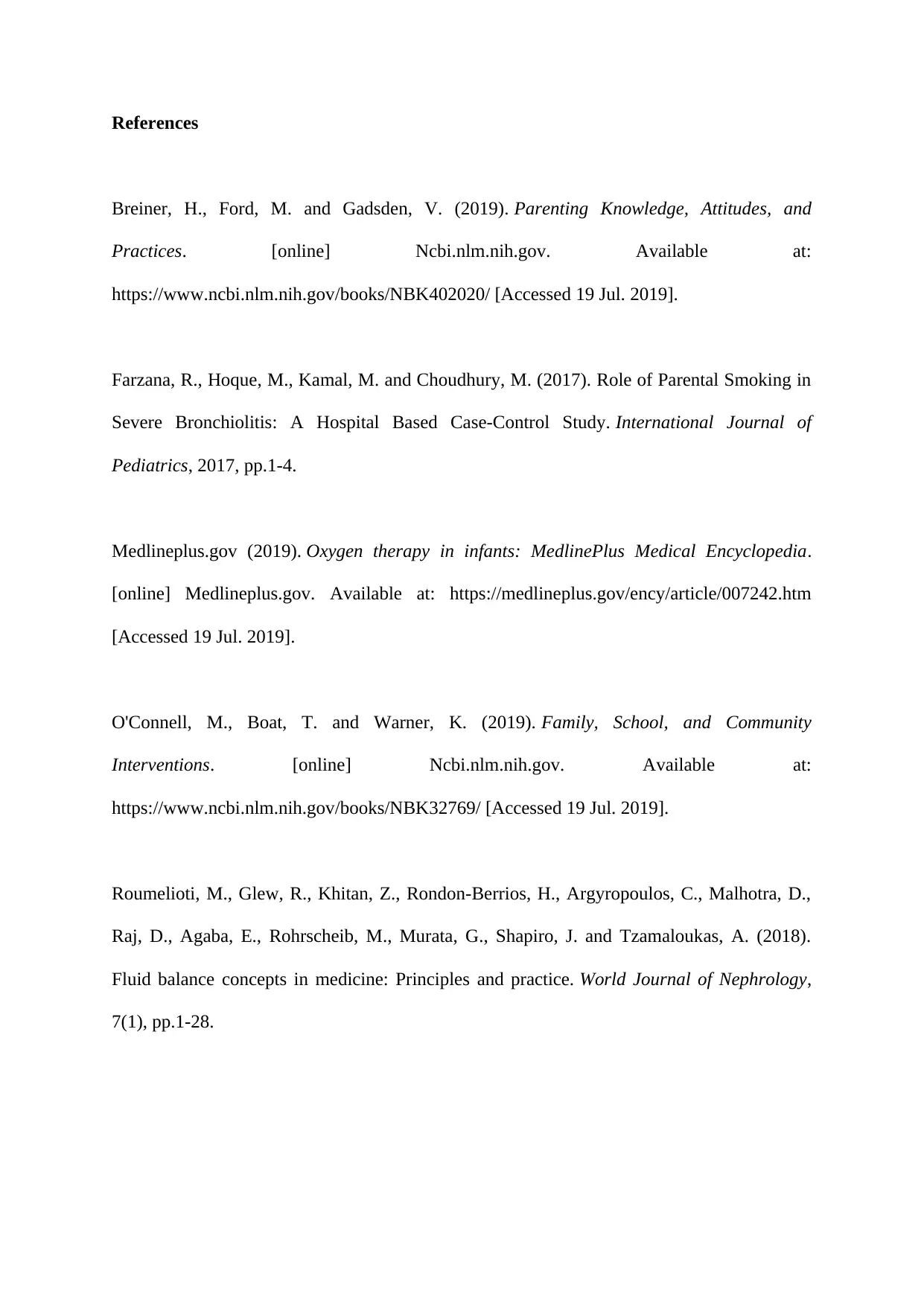
References
Breiner, H., Ford, M. and Gadsden, V. (2019). Parenting Knowledge, Attitudes, and
Practices. [online] Ncbi.nlm.nih.gov. Available at:
https://www.ncbi.nlm.nih.gov/books/NBK402020/ [Accessed 19 Jul. 2019].
Farzana, R., Hoque, M., Kamal, M. and Choudhury, M. (2017). Role of Parental Smoking in
Severe Bronchiolitis: A Hospital Based Case-Control Study. International Journal of
Pediatrics, 2017, pp.1-4.
Medlineplus.gov (2019). Oxygen therapy in infants: MedlinePlus Medical Encyclopedia.
[online] Medlineplus.gov. Available at: https://medlineplus.gov/ency/article/007242.htm
[Accessed 19 Jul. 2019].
O'Connell, M., Boat, T. and Warner, K. (2019). Family, School, and Community
Interventions. [online] Ncbi.nlm.nih.gov. Available at:
https://www.ncbi.nlm.nih.gov/books/NBK32769/ [Accessed 19 Jul. 2019].
Roumelioti, M., Glew, R., Khitan, Z., Rondon-Berrios, H., Argyropoulos, C., Malhotra, D.,
Raj, D., Agaba, E., Rohrscheib, M., Murata, G., Shapiro, J. and Tzamaloukas, A. (2018).
Fluid balance concepts in medicine: Principles and practice. World Journal of Nephrology,
7(1), pp.1-28.
Breiner, H., Ford, M. and Gadsden, V. (2019). Parenting Knowledge, Attitudes, and
Practices. [online] Ncbi.nlm.nih.gov. Available at:
https://www.ncbi.nlm.nih.gov/books/NBK402020/ [Accessed 19 Jul. 2019].
Farzana, R., Hoque, M., Kamal, M. and Choudhury, M. (2017). Role of Parental Smoking in
Severe Bronchiolitis: A Hospital Based Case-Control Study. International Journal of
Pediatrics, 2017, pp.1-4.
Medlineplus.gov (2019). Oxygen therapy in infants: MedlinePlus Medical Encyclopedia.
[online] Medlineplus.gov. Available at: https://medlineplus.gov/ency/article/007242.htm
[Accessed 19 Jul. 2019].
O'Connell, M., Boat, T. and Warner, K. (2019). Family, School, and Community
Interventions. [online] Ncbi.nlm.nih.gov. Available at:
https://www.ncbi.nlm.nih.gov/books/NBK32769/ [Accessed 19 Jul. 2019].
Roumelioti, M., Glew, R., Khitan, Z., Rondon-Berrios, H., Argyropoulos, C., Malhotra, D.,
Raj, D., Agaba, E., Rohrscheib, M., Murata, G., Shapiro, J. and Tzamaloukas, A. (2018).
Fluid balance concepts in medicine: Principles and practice. World Journal of Nephrology,
7(1), pp.1-28.
1 out of 5
Related Documents
Your All-in-One AI-Powered Toolkit for Academic Success.
+13062052269
info@desklib.com
Available 24*7 on WhatsApp / Email
![[object Object]](/_next/static/media/star-bottom.7253800d.svg)
Unlock your academic potential
Copyright © 2020–2025 A2Z Services. All Rights Reserved. Developed and managed by ZUCOL.





